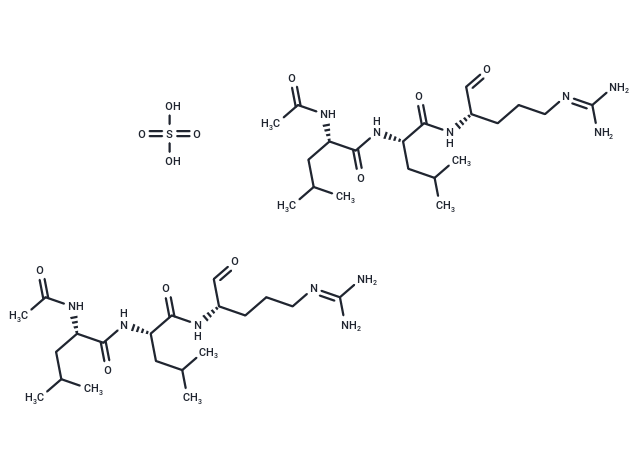Shopping Cart
Remove All Your shopping cart is currently empty
Your shopping cart is currently empty
Leupeptin hemisulfate is a protease inhibitor with cell membrane-permeable, reversible, competitive, and oral activities. Leupeptin hemisulfate inhibits the activity of Cathepsin B, Cathepsin H, and Cathepsin L, and blocks fusion of amphipathic lysosomes. Leupeptin hemisulfate also has anti-inflammatory activity.

| Pack Size | Price | USA Warehouse | Global Warehouse | Quantity |
|---|---|---|---|---|
| 5 mg | $47 | In Stock | In Stock | |
| 10 mg | $67 | In Stock | In Stock | |
| 25 mg | $112 | In Stock | In Stock | |
| 50 mg | $166 | In Stock | In Stock | |
| 100 mg | $246 | In Stock | In Stock | |
| 1 mL x 10 mM (in DMSO) | $55 | In Stock | In Stock |
| Description | Leupeptin hemisulfate is a protease inhibitor with cell membrane-permeable, reversible, competitive, and oral activities. Leupeptin hemisulfate inhibits the activity of Cathepsin B, Cathepsin H, and Cathepsin L, and blocks fusion of amphipathic lysosomes. Leupeptin hemisulfate also has anti-inflammatory activity. |
| Targets&IC50 | SARS-CoV-2 (Vero cells):42.34 µM (EC50), Huh7 cells (SARS-CoV-2):39.29 µM (EC50), Human coronavirus strain 229E:0.4 µg/mL |
| In vitro | METHODS: SARS-CoV-2 infected Vero cells were treated with Leupeptin hemisulfate (0.06-200 µM) for 72 h, and the viral RNA level was detected by RT-PCR. RESULTS: Leupeptin hemisulfate inhibited SARS-CoV-2 RNA levels in Vero cells with an EC50 value of 42.34 µM. [1] METHODS: SARS-CoV-2 pseudovirus-infected Huh7 cells were treated with Leupeptin hemisulfate (0.1-100 µM) for 24 h. Pseudovirus infection was detected by luciferase activity assay. RESULTS: Leupeptin hemisulfate inhibited pseudovirus infection in Vero cells with an EC50 value of 39.29 µM. [2] |
| In vivo | METHODS: To determine macrophage autophagic flux, Leupeptin hemisulfate (9-40 mg/kg in 0.5 mL PBS) was administered to C57BL/6NCrl mice by single intraperitoneal injection. RESULTS: Leupeptin hemisulfate treatment resulted in the highest accumulation of LC3b in the liver and the lowest in the spleen. LC3a, ATG8/LC3b homologs, and the LC3b-interacting protein p62 were degraded with kinetics similar to those of LC3b. [3] METHODS: To examine whether cold activates autophagic flux, Leupeptin hemisulfate (40 mg/kg) was administered intraperitoneally to C57B6 mice in a single injection, and then the mice were cold-exposed at 4 ℃ for 1 h. The mice were then exposed to cold for 1 h. RESULTS: LC3-II flux in brown fat was increased >2-fold in cold-exposed mice. [4] |
| Kinase Assay | Determination of BET Protein Binding Affinities to I-BET726: For determination of binding affinities to BET protein bromodomains, I-BET726 is titrated against truncates containing both BD1 and BD2 of BRD2 (10 nM), BRD3 (10 nM), and BRD4 (10 nM) in 50 mM HEPES pH7.5, 150 mM NaCl, 5% Glycerol, 1 mM DTT and 1 mM CHAPS in the presence of an Alexa 647 derivative (50 nM) of fluorescent ligand. After equilibrating for 1 h, the bromodomain protein: ligand interaction is detected using Time Resolved Fluorescence Resonance Energy Transfer (TR-FRET) following the addition of 1.5 nM europium chelate labeled anti-6His antibody. Plates are read using an Envision Plate reader (λEX = 337 nm, λEM = 615 nm, λEM = 665 nm; dual dichroic = 400 nm & 630 nm). These data are fitted to a four parameter IC50 model using Graphit data analysis software. |
| Molecular Weight | 475.59 |
| Formula | C20H38N6O4·1/2H2SO4 |
| Cas No. | 103476-89-7 |
| Smiles | OS(O)(=O)=O.CC(C)C[C@H](NC(C)=O)C(=O)N[C@@H](CC(C)C)C(=O)N[C@@H](CCCN=C(N)N)C=O.CC(C)C[C@H](NC(C)=O)C(=O)N[C@@H](CC(C)C)C(=O)N[C@@H](CCCN=C(N)N)C=O |
| Relative Density. | no data available |
| Color | White |
| Appearance | Solid |
| Sequence Short | Ac-LLR-CHO |
| Storage | keep away from moisture,store at low temperature | Powder: -20°C for 3 years | In solvent: -80°C for 1 year | Shipping with blue ice/Shipping at ambient temperature. | |||||||||||||||||||||||||||||||||||
| Solubility Information | H2O: 87 mg/mL (182.93 mM), Sonication is recommended. DMSO: 60 mg/mL (126.16 mM), Sonication is recommended. Ethanol: 88 mg/mL (185.03 mM), Sonication is recommended. | |||||||||||||||||||||||||||||||||||
Solution Preparation Table | ||||||||||||||||||||||||||||||||||||
DMSO/H2O/Ethanol
| ||||||||||||||||||||||||||||||||||||
| Size | Quantity | Unit Price | Amount | Operation |
|---|

Copyright © 2015-2025 TargetMol Chemicals Inc. All Rights Reserved.